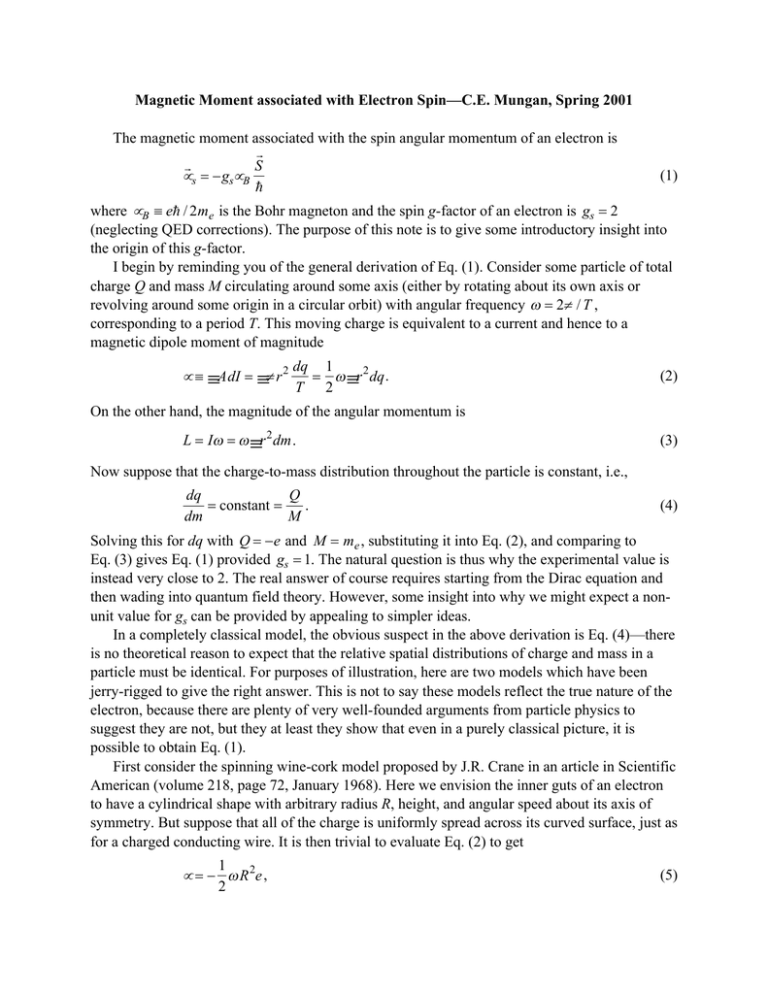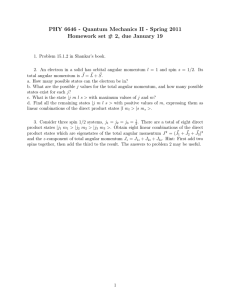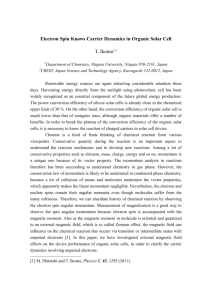Magnetic Moment associated with Electron Spin—C.E. Mungan, Spring 2001 (1) where
advertisement

Magnetic Moment associated with Electron Spin—C.E. Mungan, Spring 2001 The magnetic moment associated with the spin angular momentum of an electron is r r S µ s = − gsµ B h (1) where µ B ≡ eh / 2 me is the Bohr magneton and the spin g-factor of an electron is gs = 2 (neglecting QED corrections). The purpose of this note is to give some introductory insight into the origin of this g-factor. I begin by reminding you of the general derivation of Eq. (1). Consider some particle of total charge Q and mass M circulating around some axis (either by rotating about its own axis or revolving around some origin in a circular orbit) with angular frequency ω = 2π / T , corresponding to a period T. This moving charge is equivalent to a current and hence to a magnetic dipole moment of magnitude µ ≡ ∫ AdI = ∫ π r 2 dq 1 = ω ∫ r 2 dq . T 2 (2) On the other hand, the magnitude of the angular momentum is L = Iω = ω ∫ r 2 dm . (3) Now suppose that the charge-to-mass distribution throughout the particle is constant, i.e., dq Q . = constant = dm M (4) Solving this for dq with Q = −e and M = me , substituting it into Eq. (2), and comparing to Eq. (3) gives Eq. (1) provided gs = 1. The natural question is thus why the experimental value is instead very close to 2. The real answer of course requires starting from the Dirac equation and then wading into quantum field theory. However, some insight into why we might expect a nonunit value for gs can be provided by appealing to simpler ideas. In a completely classical model, the obvious suspect in the above derivation is Eq. (4)—there is no theoretical reason to expect that the relative spatial distributions of charge and mass in a particle must be identical. For purposes of illustration, here are two models which have been jerry-rigged to give the right answer. This is not to say these models reflect the true nature of the electron, because there are plenty of very well-founded arguments from particle physics to suggest they are not, but they at least they show that even in a purely classical picture, it is possible to obtain Eq. (1). First consider the spinning wine-cork model proposed by J.R. Crane in an article in Scientific American (volume 218, page 72, January 1968). Here we envision the inner guts of an electron to have a cylindrical shape with arbitrary radius R, height, and angular speed about its axis of symmetry. But suppose that all of the charge is uniformly spread across its curved surface, just as for a charged conducting wire. It is then trivial to evaluate Eq. (2) to get 1 µ = − ω R 2e , 2 (5) while the angular momentum is just that of a flat disk of assumed uniform mass density, 1 S = ω me R 2 . 2 (6) Inserting these into Eq. (1) gives gs = 2 , as desired. One may object that an electron does not have cylindrical symmetry. So here is another model, proposed by M. Ambou (http://www.ctv.es/USERS/positivo/electron/electron.html) in which the electron is visualized as a sphere of radius R, on the surface of which the charge is uniformly distributed. This corresponds to a surface charge density of σ = −e / 4π R 2 , so that dq = σ dA where dA is the surface area of a a little ring of cylindrical radius r circling the axis of rotation. This area is the product of its circumference 2π r and its width Rdθ , where θ is the polar angle and varies from 0 to π across the surface. r ω r θ r ω R r R TOP VIEW SIDE VIEW We see from the geometry that r = R sin θ and thus Eq. (2) becomes π eω 3 1 r dθ = − 41 eω R 2 ∫ sin θ (1 − cos2 θ ) dθ µ = ω ∫ r 2σ dA = − ∫ 2 4R [ = − 41 eω R 2 cosθ − 13 cos3 θ ] 0 0 π (7) = − 13 eω R 2 . Next we suppose that the mass density ρ of the electron is not uniform but that the lepton is a “fuzzy cloud,” with the mass concentrated at its center and falling off inversely with distance, ρ( a) = me −1 a 2πR 2 (8) where the prefactor has been chosen so that when ρ is integrated from 0 to R one properly gets me. To avoid confusion with the cylindrical radius r (which is the distance outward from the axis of rotation), I have denoted the spherical radius by a (i.e., this is the distance measured from the center of the sphere). Now compute the angular momentum as me S = ω ∫ r ρ dV = ω 2π R 2 2π π R 2 ∫ ∫ ∫ (a sinθ ) 0 00 2 1 2 a sin θ dadθ dφ = 13 meω R 2 . a (9) Inserting Eqs. (7) and (9) into Eq. (1) again implies gs = 2 . However, the electron is actually believed to be a point particle with no internal structure. Hence it would be more satisfying to be able to obtain this g-factor from at least a semiclassical approach. A method for doing so is discussed in AJP 29, 582 (1961) and goes as follows. We wish to consider the energy K + U of an electron that has both r r orbital r and rspinrangular B = ∇ × A momentum in the presence of electric and magnetic fields, and , where φ φ = − E ∇ r and A are the electric scalar and magnetic vector potentials, respectively. In order to handle the r spin, we introduce the vector σ whose components are the Pauli spin matrices, 0 1 0 −i 1 0 σx = , σy = , σz = . 1 0 i 0 0 −1 (10) If the 2 × 2 identity matrix (written simply as 1) is appended to this set, these four matrices form a basis spanning all possible 2 × 2 matrices. It is easy to verify that the matrices in Eq. (10) satisfy the remarkable relationship 3 σ jσ k = δ jk + i ∑ ∈ jkl σ l . (11) l =1 In words this says that if you multiply any spin matrix by itself you get the identity matrix, while if you multiply any Pauli matrix by a different matrix you get ±i times the remaining matrix, with a plus sign if the two factors are in the order of a right-handed coordinate system and a minus sign otherwise. For example, σ yσ y = 1, σ xσ z = −iσ y , and so forth. Now the potential energy of the electron is U = −eφ due to the Coulombic interaction between the electron and the screened nucleus, while the kinetic energy is r r p2 (σ ⋅ p) 2 K= = . (12) 2 me 2 me The second equality can be verified by writing out the dot product in Cartesian coordinates, squaring the result while preserving order, and then applying Eq. (11) to each of the nine resulting terms. We now apply the standard quantum mechanical conversion r r r (13) p → −ih∇ + eA to Eq. (12) to obtain K= 1 2 me ∑ σ j (−ih∂ j + eA j )σ k (−ih∂ k + eAk ) , 3 (14) j ,k = 1 where the notation means, for example, ∂ 2 ≡ ∂ / ∂y . This can be simplified using Eq. (11) and the definition of the curl, r r (∇ × A) l ≡ 3 ∑ ∈jkl ∂ j Ak , (15) j ,k = 1 to give the final result r r 1 − i h ∇ + eA 2 me r r r r r p2 + µ Bσ ⋅ B − eφ . + ehσ ⋅ ∇ × A − eφ = (16) 2 me r r r r We identify the middle term as the energy of a magnetic dipole, −µ ⋅ B , by putting S = 12 hσ since the magnitude of the electron spin is 12 h . Comparison to the form of Eq. (1) now shows that gs = 2 . K +U = ( ) 2 ( )




